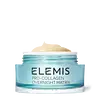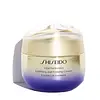What's inside
What's inside
 Key Ingredients
Key Ingredients

 Benefits
Benefits

 Concerns
Concerns

 Ingredients Side-by-side
Ingredients Side-by-side

Water
Skin ConditioningGlycerin
HumectantOlus Oil
EmollientPropanediol
SolventBehenyl Alcohol
EmollientSqualane
EmollientButylene Glycol
HumectantOctyldodecanol
EmollientDicaprylyl Carbonate
EmollientHelianthus Annuus Seed Oil
EmollientPhenoxyethanol
PreservativeAcrylates/C10-30 Alkyl Acrylate Crosspolymer
Emulsion StabilisingBeheneth-25
CleansingGlyceryl Acrylate/Acrylic Acid Copolymer
HumectantBenzoic Acid
MaskingLavandula Angustifolia Oil
MaskingDisodium EDTA
Dunaliella Salina Extract
Skin ConditioningRhizobian Gum
Sodium Hyaluronate
HumectantDehydroacetic Acid
PreservativeLinalool
PerfumingLavandula Hybrida Oil
EmollientPelargonium Graveolens Flower Oil
MaskingPadina Pavonica Thallus Extract
Skin ConditioningGeraniol
PerfumingEucalyptus Globulus Leaf Oil
PerfumingChlorphenesin
AntimicrobialPlankton Extract
Skin ConditioningAnthemis Nobilis Flower Oil
MaskingCitronellol
PerfumingPotassium Sorbate
PreservativeSodium Benzoate
MaskingCaramel
Cosmetic ColorantCinnamomum Camphora Wood Oil
MaskingLimonene
PerfumingMentha Arvensis Leaf Oil
MaskingTocopherol
AntioxidantXanthan Gum
EmulsifyingCaprylyl Glycol
EmollientCitrus Aurantium Dulcis Oil
MaskingParfum
MaskingTephrosia Purpurea Seed Extract
Skin ConditioningVitis Vinifera Seed Oil
EmollientMenthol
MaskingEugenia Caryophyllus Leaf Oil
MaskingSodium Hydroxide
BufferingGlyceryl Caprylate
EmollientLactic Acid/Glycolic Acid Copolymer
Skin ConditioningPhenylpropanol
MaskingPalmitoyl Tetrapeptide-50
Skin ConditioningPolyvinyl Alcohol
Heptapeptide-15 Palmitate
Skin ConditioningWater, Glycerin, Olus Oil, Propanediol, Behenyl Alcohol, Squalane, Butylene Glycol, Octyldodecanol, Dicaprylyl Carbonate, Helianthus Annuus Seed Oil, Phenoxyethanol, Acrylates/C10-30 Alkyl Acrylate Crosspolymer, Beheneth-25, Glyceryl Acrylate/Acrylic Acid Copolymer, Benzoic Acid, Lavandula Angustifolia Oil, Disodium EDTA, Dunaliella Salina Extract, Rhizobian Gum, Sodium Hyaluronate, Dehydroacetic Acid, Linalool, Lavandula Hybrida Oil, Pelargonium Graveolens Flower Oil, Padina Pavonica Thallus Extract, Geraniol, Eucalyptus Globulus Leaf Oil, Chlorphenesin, Plankton Extract, Anthemis Nobilis Flower Oil, Citronellol, Potassium Sorbate, Sodium Benzoate, Caramel, Cinnamomum Camphora Wood Oil, Limonene, Mentha Arvensis Leaf Oil, Tocopherol, Xanthan Gum, Caprylyl Glycol, Citrus Aurantium Dulcis Oil, Parfum, Tephrosia Purpurea Seed Extract, Vitis Vinifera Seed Oil, Menthol, Eugenia Caryophyllus Leaf Oil, Sodium Hydroxide, Glyceryl Caprylate, Lactic Acid/Glycolic Acid Copolymer, Phenylpropanol, Palmitoyl Tetrapeptide-50, Polyvinyl Alcohol, Heptapeptide-15 Palmitate
Water
Skin ConditioningButylene Glycol
HumectantDimethicone
EmollientGlycerin
HumectantAlcohol Denat.
AntimicrobialPPG-3 Dipivalate
Skin ConditioningGlyceryl Stearate Se
EmulsifyingCetyl Alcohol
EmollientPentaerythrityl Tetraethylhexanoate
EmollientHydrogenated Polydecene
EmollientMyristyl Myristate
EmollientPEG-100 Stearate
Silica
AbrasiveBis-Diglyceryl Polyacyladipate-2
EmollientPotassium Methoxysalicylate
BleachingBehenyl Alcohol
EmollientSodium Acrylate/Sodium Acryloyldimethyl Taurate Copolymer
Emulsion StabilisingStearyl Alcohol
EmollientPolyvinyl Alcohol
Phenoxyethanol
PreservativeIsohexadecane
EmollientParfum
MaskingPolysorbate 80
EmulsifyingSorbitan Tristearate
EmulsifyingTrisodium EDTA
Erythritol
HumectantPEG/PPG-14/7 Dimethyl Ether
Skin ConditioningPEG/PPG-17/4 Dimethyl Ether
Skin ConditioningTocopheryl Acetate
AntioxidantRosa Damascena Flower Water
MaskingSodium Citrate
BufferingSuccinoglycan
Skin ConditioningAlcohol
AntimicrobialSorbitan Oleate
EmulsifyingCaffeine
Skin ConditioningCitric Acid
BufferingSodium Metaphosphate
BufferingLavandula Angustifolia Oil
MaskingPhytosteryl/Octyldodecyl Lauroyl Glutamate
Skin ConditioningLimonene
PerfumingHexyl Cinnamal
PerfumingTocopherol
AntioxidantLinalool
PerfumingCitronellol
PerfumingSodium Metabisulfite
AntioxidantCI 77492
Cosmetic ColorantAngelica Acutiloba Root Extract
Skin ConditioningAngelica Keiskei Leaf/Stem Extract
Skin ConditioningOlea Europaea Leaf Extract
PerfumingLamium Album Flower/Leaf/Stem Extract
Skin ConditioningCellulose
AbsorbentCamellia Sinensis Leaf Extract
AntimicrobialInositol
HumectantCarthamus Tinctorius Flower Extract
Skin ConditioningCI 77491
Cosmetic ColorantZiziphus Jujuba Fruit Extract
Skin ConditioningRosmarinus Officinalis Leaf Extract
AntimicrobialHydrolyzed Silk
HumectantBupleurum Falcatum Root Extract
Skin ConditioningWater, Butylene Glycol, Dimethicone, Glycerin, Alcohol Denat., PPG-3 Dipivalate, Glyceryl Stearate Se, Cetyl Alcohol, Pentaerythrityl Tetraethylhexanoate, Hydrogenated Polydecene, Myristyl Myristate, PEG-100 Stearate, Silica, Bis-Diglyceryl Polyacyladipate-2, Potassium Methoxysalicylate, Behenyl Alcohol, Sodium Acrylate/Sodium Acryloyldimethyl Taurate Copolymer, Stearyl Alcohol, Polyvinyl Alcohol, Phenoxyethanol, Isohexadecane, Parfum, Polysorbate 80, Sorbitan Tristearate, Trisodium EDTA, Erythritol, PEG/PPG-14/7 Dimethyl Ether, PEG/PPG-17/4 Dimethyl Ether, Tocopheryl Acetate, Rosa Damascena Flower Water, Sodium Citrate, Succinoglycan, Alcohol, Sorbitan Oleate, Caffeine, Citric Acid, Sodium Metaphosphate, Lavandula Angustifolia Oil, Phytosteryl/Octyldodecyl Lauroyl Glutamate, Limonene, Hexyl Cinnamal, Tocopherol, Linalool, Citronellol, Sodium Metabisulfite, CI 77492, Angelica Acutiloba Root Extract, Angelica Keiskei Leaf/Stem Extract, Olea Europaea Leaf Extract, Lamium Album Flower/Leaf/Stem Extract, Cellulose, Camellia Sinensis Leaf Extract, Inositol, Carthamus Tinctorius Flower Extract, CI 77491, Ziziphus Jujuba Fruit Extract, Rosmarinus Officinalis Leaf Extract, Hydrolyzed Silk, Bupleurum Falcatum Root Extract
Ingredients Explained
These ingredients are found in both products.
Ingredients higher up in an ingredient list are typically present in a larger amount.
Behenyl Alcohol is a type of fatty alcohol (these are different from the drying, solvent alcohols).
Fatty Alcohols have hydrating properties and are most often used as an emollient or to thicken a product. They are usually derived from natural fats and oils; behenyl alcohol is derived from the fats of vegetable oils.
Emollients help keep your skin soft and hydrated by creating a film that traps moisture in.
In 2000, Behenyl Alcohol was approved by the US as medicine to reduce the duration of cold sores.
Learn more about Behenyl AlcoholButylene Glycol (or BG) is used within cosmetic products for a few different reasons:
Overall, Butylene Glycol is a safe and well-rounded ingredient that works well with other ingredients.
Though this ingredient works well with most skin types, some people with sensitive skin may experience a reaction such as allergic rashes, closed comedones, or itchiness.
Learn more about Butylene GlycolCitronellol is used to add fragrance/parfum to a product. It is often derived from plants such as roses. In fact, it can be found in many essential oils including geranium, lavender, neroli, and more. The scent of Citronellol is often described as "fresh, grassy, and citrus-like".
Since the Citronellol molecule is already unstable, Citronellol becomes irritating on the skin when exposed to air.
Citronellol is a modified terpene. Terpenes are unsaturated hydrocarbons found in plants. They make up the primary part of essential oils.
Citronellol is not able to be absorbed into deeper layers of the skin. It has low permeability,
Citronellol is also a natural insect repellent.
Learn more about CitronellolGlycerin is already naturally found in your skin. It helps moisturize and protect your skin.
A study from 2016 found glycerin to be more effective as a humectant than AHAs and hyaluronic acid.
As a humectant, it helps the skin stay hydrated by pulling moisture to your skin. The low molecular weight of glycerin allows it to pull moisture into the deeper layers of your skin.
Hydrated skin improves your skin barrier; Your skin barrier helps protect against irritants and bacteria.
Glycerin has also been found to have antimicrobial and antiviral properties. Due to these properties, glycerin is often used in wound and burn treatments.
In cosmetics, glycerin is usually derived from plants such as soybean or palm. However, it can also be sourced from animals, such as tallow or animal fat.
This ingredient is organic, colorless, odorless, and non-toxic.
Glycerin is the name for this ingredient in American English. British English uses Glycerol/Glycerine.
Learn more about GlycerinLavandula Angustifolia Oil is more commonly known as lavender essential oil. It is considered a fragrancing ingredient.
Lavender imparts a famous scent. While the smell is lovely, this ingredient and may sensitize skin in topical products. This is because about 85% of the oil is made up of linalool and linalyl acetate.
When exposed to air, these two compounds become strong allergens. This ingredient exhibits cytotoxicity at low concentrations; amounts of 0.25% have been shown to damage skin cells.
A study from Japan found this ingredient caused lavender sensitivity after widespread exposure.
Lavender essential oil has some antimicrobial, antibacterial, and anti-inflammatory properties. However, the cons of this ingredient may outweight the pros.
More research is needed to confirm lavender essential oil's effects when used in aromatherapy.
Lavandula Angustifolia is known as the English Lavender and famous for creating purple fields in Provence, France.
Learn more about Lavandula Angustifolia OilLimonene is a fragrance that adds scent and taste to a formulation.
It's found in the peel oil of citrus fruits and other plants such as lavender and eucalyptus. The scent of limonene is generally described as "sweet citrus".
Limonene acts as an antioxidant, meaning it helps neutralize free radicals.
When exposed to air, oxidized limonene may sensitize the skin. Because of this, limonene is often avoided by people with sensitive skin.
The term 'fragrance' is not regulated in many countries. In many cases, it is up to the brand to define this term. For instance, many brands choose to label themselves as "fragrance-free" because they are not using synthetic fragrances. However, their products may still contain ingredients such as essential oils that are considered a fragrance.
Learn more about LimoneneLinalool is a fragrance and helps add scent to products. It's derived from common plants such as cinnamon, mint, citrus, and lavender.
Like Limonene, this ingredient oxidizes when exposed to air. Oxidized linalool can cause allergies and skin sensitivity.
This ingredient has a scent that is floral, spicy tropical, and citrus-like.
Learn more about LinaloolParfum is a catch-all term for an ingredient or more that is used to give a scent to products.
Also called "fragrance", this ingredient can be a blend of hundreds of chemicals or plant oils. This means every product with "fragrance" or "parfum" in the ingredients list is a different mixture.
For instance, Habanolide is a proprietary trade name for a specific aroma chemical. When used as a fragrance ingredient in cosmetics, most aroma chemicals fall under the broad labeling category of “FRAGRANCE” or “PARFUM” according to EU and US regulations.
The term 'parfum' or 'fragrance' is not regulated in many countries. In many cases, it is up to the brand to define this term.
For instance, many brands choose to label themselves as "fragrance-free" because they are not using synthetic fragrances. However, their products may still contain ingredients such as essential oils that are considered a fragrance by INCI standards.
One example is Calendula flower extract. Calendula is an essential oil that still imparts a scent or 'fragrance'.
Depending on the blend, the ingredients in the mixture can cause allergies and sensitivities on the skin. Some ingredients that are known EU allergens include linalool and citronellol.
Parfum can also be used to mask or cover an unpleasant scent.
The bottom line is: not all fragrances/parfum/ingredients are created equally. If you are worried about fragrances, we recommend taking a closer look at an ingredient. And of course, we always recommend speaking with a professional.
Learn more about ParfumPhenoxyethanol is a preservative that has germicide, antimicrobial, and aromatic properties. Studies show that phenoxyethanol can prevent microbial growth. By itself, it has a scent that is similar to that of a rose.
It's often used in formulations along with Caprylyl Glycol to preserve the shelf life of products.
We don't have a description for Polyvinyl Alcohol yet.
Tocopherol (also known as Vitamin E) is a common antioxidant used to help protect the skin from free-radicals and strengthen the skin barrier. It's also fat soluble - this means our skin is great at absorbing it.
Vitamin E also helps keep your natural skin lipids healthy. Your lipid skin barrier naturally consists of lipids, ceramides, and fatty acids. Vitamin E offers extra protection for your skin’s lipid barrier, keeping your skin healthy and nourished.
Another benefit is a bit of UV protection. Vitamin E helps reduce the damage caused by UVB rays. (It should not replace your sunscreen). Combining it with Vitamin C can decrease sunburned cells and hyperpigmentation after UV exposure.
You might have noticed Vitamin E + C often paired together. This is because it is great at stabilizing Vitamin C. Using the two together helps increase the effectiveness of both ingredients.
There are often claims that Vitamin E can reduce/prevent scarring, but these claims haven't been confirmed by scientific research.
Learn more about TocopherolWater. It's the most common cosmetic ingredient of all. You'll usually see it at the top of ingredient lists, meaning that it makes up the largest part of the product.
So why is it so popular? Water most often acts as a solvent - this means that it helps dissolve other ingredients into the formulation.
You'll also recognize water as that liquid we all need to stay alive. If you see this, drink a glass of water. Stay hydrated!
Learn more about Water